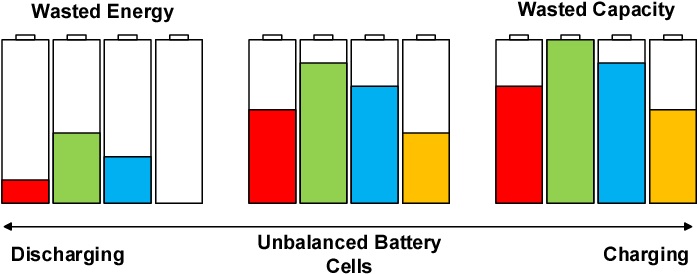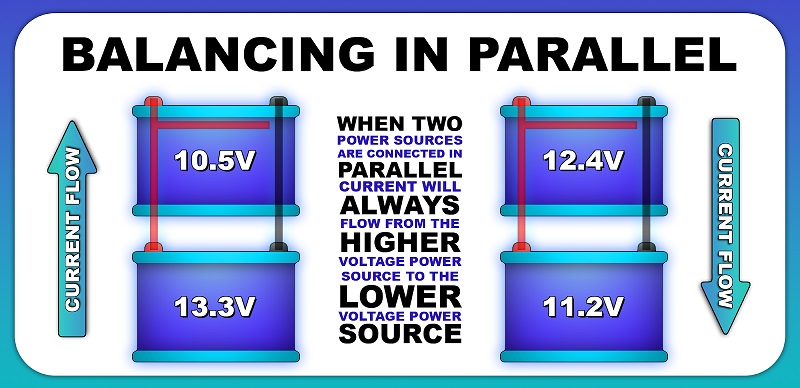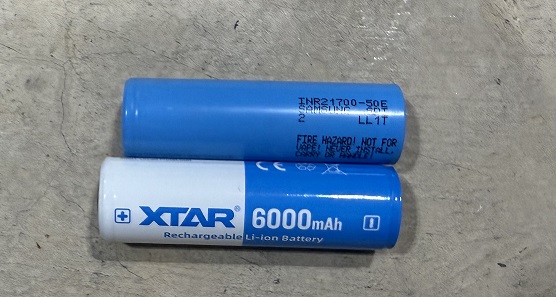
How Do You Balance Lithium Batteries In Parallel?
Table of Contents
Balancing lithium batteries in parallel involves measuring each battery's voltage before connection, ensuring they're within an acceptable range of each other, and then connecting all positive and negative terminals together.
What Does It Mean For Lithium Batteries To Be Balanced?
Battery balancing refers to the process of ensuring all individual cells or groups of cells within a battery (or multiple batteries in a system) maintain the same voltage levels. In lithium batteries, maintaining balance is crucial because it allows for the most efficient use of the battery's total capacity. It also prolongs the battery's lifespan by preventing overcharging or over-discharging of individual cells.

Battery balancers and battery management systems continuously monitor voltages and redistribute energy by shuffling power between cells to keep them all at the same state of charge. This balances the cells and prevents any one cell from moving too far out of sync from the overall battery pack voltage. Proper balancing keeps all cells operating at optimal capacity and safety throughout the life of the battery.
What Does It Mean For Lithium Battery Packs To Be Balanced?
Balancing lithium battery packs, like individual cells, involves ensuring that all batteries within a system maintain the same state of charge. This process is essential when multiple battery packs are used together in series or parallel configurations. Keeping the battery packs balanced helps to optimize the total capacity of the system, extend battery life, and maintain safe operation.In a system using multiple battery packs, the connection method plays a vital role. Wiring batteries in series increases the total voltage while wiring batteries in parallel increases the capacity. It's essential to size the cable correctly for your series and parallel connections. Incorrect cable size can lead to unequal resistance, which can cause some battery packs to work harder than others, thereby causing an imbalance.
Manual monitoring is generally required for multi-battery arrays as there are not any on the market just yet. In the case of a home-based battery, many have opted to build custom systems to monitor powerwalls. Regular checks and measurements of each battery pack's voltage can help ensure that all are charging and discharging evenly. The more symmetrical and even the wiring, the more likely all battery packs are to remain balanced.
Unbalanced battery packs can lead to inefficient operation and shortened lifespan. For example, one battery pack might end up shouldering a heavier load than the others, leading to it aging faster. This can be avoided by proper cable sizing, balanced wiring, and regular monitoring, which all ensure that power is equally distributed across all the battery packs in a system.
How To Balance Lithium Batteries In Parallel
In a parallel configuration, multiple batteries are connected positive terminal to positive terminal and negative terminal to negative terminal. This increases the total capacity and current delivery without changing the voltage.

Step 1: Measure Battery Voltage
Using the multimeter, measure the voltage of each lithium battery you plan to connect in parallel. Record each battery's voltage for reference.
Step 2: Compare Voltage Readings
Review the voltage of each battery. They should all have approximately the same voltage to ensure balance. The acceptable margin can vary, but it's generally within 0.1V.
NOTE: Any difference in battery voltage will cause a certain amount of current to flow between battery packs. The amount of current is totally unregulated and is only limited by Ohms law. This means that the difference in voltage and the combined ISR (Internal Series Resistance) of each battery is the only limiting factor to current flow.

Step 3: Connect Batteries in Parallel
If the batteries' voltages are within the acceptable range, you can proceed to connect them in parallel. This means connecting all the positive terminals together and all the negative terminals together.
It’s important to consider the fact that while the batteries as a whole will balance when put in parallel, the individual cell groups within each battery won't balance with each other cell groups in the other battery. Each battery's internal Battery Management System (BMS) will manage its cell groups as usual, ensuring that they remain balanced within the individual battery. So making sure each battery pack has the best BMS for its chemistry is crucial to the overall balance of the system.
Best Practices Connecting Lithium Batteries In Parallel
While batteries in parallel will generally balance each other, there are a few tips to ensure this process occurs smoothly:
Regularly check the voltage of each battery: Frequent checks can help detect any imbalance early and address it before it leads to battery damage.
Use batteries with similar capacities and health: Mixing old and new batteries or batteries with different capacities can lead to imbalances and inefficiencies.
Monitor the temperature: Batteries that are overheating could indicate an imbalance. Regular temperature checks can help detect this issue.
Disconnect and charge separately if necessary: If you find a significant imbalance that isn't correcting itself, you may need to disconnect the batteries and charge them separately to bring them back to the same voltage level.


